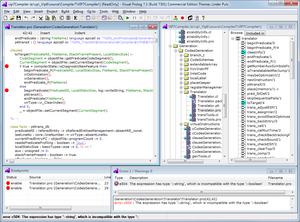Visual Prolog
 | |
| Paradigm | multi-paradigm:logical,functional,object-oriented,imperative,declarative,generic,concurrent |
|---|---|
| Developer | PDC A/S |
| Stable release | 11 build 1105
/ January 11, 2024 |
| Typing discipline | static,strong,inferred |
| OS | Windows |
| License | Proprietary |
| Website | www |
Visual Prolog,previously known asPDC PrologandTurbo Prolog,is a strongly typed object-oriented extension ofProlog.It was marketed byBorlandas Turbo Prolog (version 1.0 in 1986 and version 2.0 in 1988). It is now developed and marketed by the Danish firm PDC that originally created it. Visual Prolog can buildMicrosoft WindowsGUI-applications,console applications,DLLs(dynamic link libraries), andCGI-programs. It can also link toCOM componentsand todatabasesby means ofODBC.
Visual Prolog contains acompilerwhich generatesx86andx86-64machine code. Unlike standard Prolog, programs written in Visual Prolog arestatically typed.This allows some errors to be caught at compile-time instead of run-time.
History
[edit]| Version | New features |
|---|---|
| Version 11 | introduces suspending predicates for asynchronous programming[1] |
| Version 10 | introduces object expressions, support for master/slave processes,Microsoft EdgewebView2 control and some support forDirect2D+DirectWrite+Windows Imaging Component.[2] |
| Version 9 | introduces bounded polymorphism, extension predicates, threadsafe lock free fact databases, named parameters.[3] |
| Version 8 | introduces presenters, for more user friendly data presentation in debugger and running program.[4] |
| Version 7.5 | contains http server and LALR(1) parser generator.[5] |
| Version 7.4 | can generate 64 bit windows code.[6] |
| Version 7.3 | introduced generic classes and interfaces (seeGeneric programming), guardedmonitors.[7] |
| Version 7.2 | introduced anonymous predicates (a logical pendant toanonymous functions) and namespaces.[8] |
| Version 7.0 | introducedparametric polymorphism. |
| Sinceversion 6.0 | the language has been fullyobject-oriented. |
Hanoi example
[edit]In theTowers of Hanoiexample, the Prolog inference engine figures out how to move a stack of any number of progressively smaller disks, one at a time, from the left pole to the right pole in the described way, by means of a center as transit, so that there's never a bigger disk on top of a smaller disk. The predicatehanoitakes an integer indicating the number of disks as an initial argument.
classhanoi
predicates
hanoi:(unsignedN).
endclasshanoi
implementhanoi
domains
pole=left;center;right.
clauses
hanoi(N):-move(N,left,center,right).
classpredicates
move:(unsignedN,poleA,poleB,poleC).
clauses
move(0,_,_,_):-!.
move(N,A,B,C):-
move(N-1,A,C,B),
stdio::writef("move a disc from % pole to the % pole\n",A,C),
move(N-1,B,A,C).
endimplementhanoi
goal
console::init(),
hanoi::hanoi(4).
Reception
[edit]Bruce F. WebsterofBYTEpraised Turbo Prolog in September 1986, stating that it was the first Borland product to excite him as much as Turbo Pascal did. He liked the user interface and low price, and reported that twoBYUprofessors stated that it was superior to the Prolog they used at the university. While questioning the market demand for the language, Webster concluded that "Turbo Prolog may be as significant a leap in software design as Turbo Pascal represented three years ago", and recommended it to those "at all interested in artificial intelligence, databases, expert systems, or new ways of thinking about programming".[9]Another author in the magazine that month wrote that the language's nonstandard, more structured syntax as making "source listings much more readable than those of standard Prolog". While stating that it had "many good features", he stated that Turbo Prolog's "Turbo Pascal flavor in its compiler and strong data typing... create an identity problem for the language". Describing it as "Turbo Paslog", the author concluded that he does "not recommend it if you are seriously considering becoming a Prolog programmer".[10]The magazine in 1989 listed Turbo Prolog 2.0 as among the "Distinction" winners of the BYTE Awards, approving of how Borland had "developed a system for real-world applications programming".[11]
Books about Visual Prolog
[edit]- Thomas W. de Boer,A Beginners Guide to Visual Prolog
- Eduardo Costa,Visual Prolog for Tyros
- Giovanni Torrero,VISUAL PROLOG PER PRINCIPIANTIItalian113 pages (pdf)
- Randall Scott, A Guide to Artificial Intelligence with Visual Prolog,ISBN978-1-4327-4936-1
See also
[edit]- Comparison of Prolog implementations
- Logtalk
- Mercury (programming language)
- Prolog syntax and semantics
References
[edit]- ^Visual Prolog 11 New Features
- ^Visual Prolog 10 New Features
- ^Visual Prolog 9 New Features
- ^Visual Prolog 8 New Features
- ^Visual Prolog 7.5 New Features
- ^Visual Prolog 7.4 New Features
- ^Visual Prolog 7.3 New Features
- ^Visual Prolog 7.2 New Features
- ^Webster, Bruce F. (September 1986)."Two Fine Products".BYTE.p. 335.
- ^Shammas, Namir Clement (September 1986). "Turbo Prolog".BYTE.p. 293.
- ^"The BYTE Awards".BYTE.January 1989. p. 327.
External links
[edit]- Class-based programming languages
- Borland software
- Compilers and interpreters
- Integrated development environments
- Multi-paradigm programming languages
- Prolog programming language family
- Functional logic programming languages
- Object-oriented programming languages
- Statically typed programming languages
- Programming tools for Windows
- Programming languages
